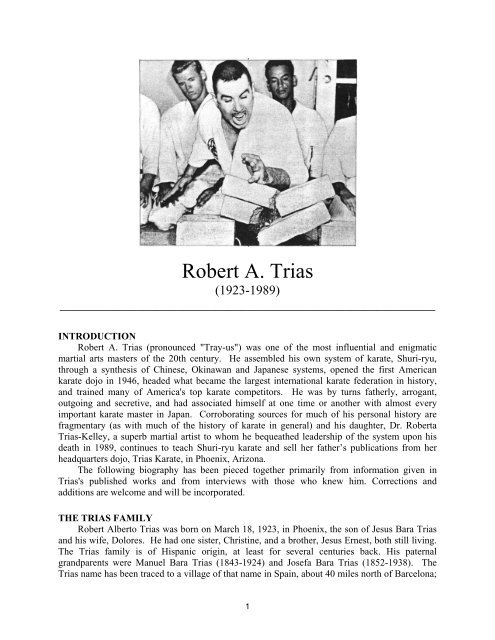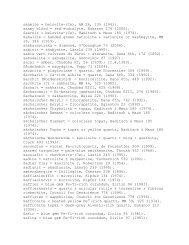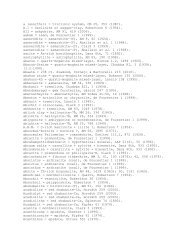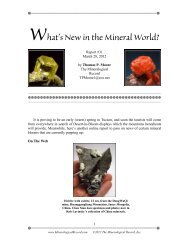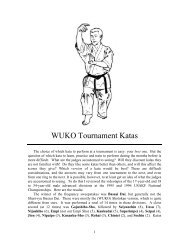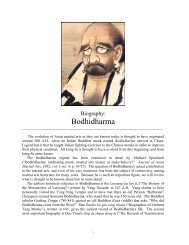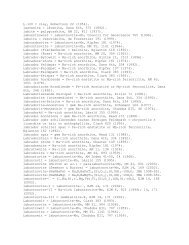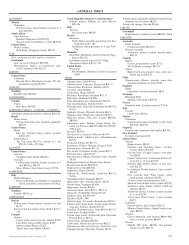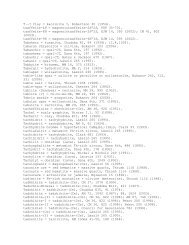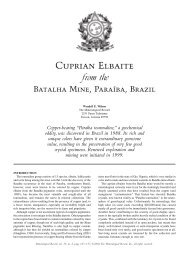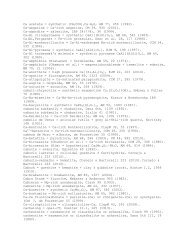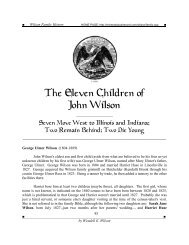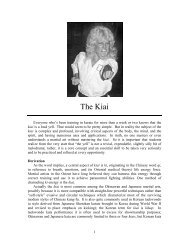Biography - Robert A. Trias
Biography - Robert A. Trias
Biography - Robert A. Trias
You also want an ePaper? Increase the reach of your titles
YUMPU automatically turns print PDFs into web optimized ePapers that Google loves.
<strong>Robert</strong> A. <strong>Trias</strong><br />
(1923-1989)<br />
__________________________________________________________<br />
INTRODUCTION<br />
<strong>Robert</strong> A. <strong>Trias</strong> (pronounced "Tray-us") was one of the most influential and enigmatic<br />
martial arts masters of the 20th century. He assembled his own system of karate, Shuri-ryu,<br />
through a synthesis of Chinese, Okinawan and Japanese systems, opened the first American<br />
karate dojo in 1946, headed what became the largest international karate federation in history,<br />
and trained many of America's top karate competitors. He was by turns fatherly, arrogant,<br />
outgoing and secretive, and had associated himself at one time or another with almost every<br />
important karate master in Japan. Corroborating sources for much of his personal history are<br />
fragmentary (as with much of the history of karate in general) and his daughter, Dr. <strong>Robert</strong>a<br />
<strong>Trias</strong>-Kelley, a superb martial artist to whom he bequeathed leadership of the system upon his<br />
death in 1989, continues to teach Shuri-ryu karate and sell her father’s publications from her<br />
headquarters dojo, <strong>Trias</strong> Karate, in Phoenix, Arizona.<br />
The following biography has been pieced together primarily from information given in<br />
<strong>Trias</strong>'s published works and from interviews with those who knew him. Corrections and<br />
additions are welcome and will be incorporated.<br />
THE TRIAS FAMILY<br />
<strong>Robert</strong> Alberto <strong>Trias</strong> was born on March 18, 1923, in Phoenix, the son of Jesus Bara <strong>Trias</strong><br />
and his wife, Dolores. He had one sister, Christine, and a brother, Jesus Ernest, both still living.<br />
The <strong>Trias</strong> family is of Hispanic origin, at least for several centuries back. His paternal<br />
grandparents were Manuel Bara <strong>Trias</strong> (1843-1924) and Josefa Bara <strong>Trias</strong> (1852-1938). The<br />
<strong>Trias</strong> name has been traced to a village of that name in Spain, about 40 miles north of Barcelona;<br />
1
also to another <strong>Trias</strong> village in the Spanish municipality of Villa Viciosa in Asturias; and as a<br />
surname among nobility in Cataluña, Spain. The surname <strong>Trias</strong>, however, may actually have<br />
originated in Greece. It is currently known (but rarely) in various Hispanic countries (Spain,<br />
Philippines, Argentina, Uruguay, Mexico) as well as Portugal, Singapore, Greece and the<br />
American Southwest.<br />
<strong>Trias</strong> enjoyed an unremarkable childhood in Phoenix, became a Star Scout in the Boy<br />
Scouts, and joined the military at age 17. He served in the Pacific during World Was II, fought<br />
on the Armed Forces Boxing Team, and returned home in 1945. He married Jane Rita<br />
Arkenberg in 1947. Their only child was <strong>Robert</strong>a Jane, born in 1948.<br />
DEVELOPMENT OF TRIAS'S STYLE<br />
<strong>Trias</strong>'s style, now known officially as Shuri-ryu, evolved over time. His first instructor, the<br />
issuer of his first black belt certificate in 1943, was T’ung (or Tong) Gee Hsing. T’ung was a<br />
long-time master of the Chinese fighting art of Hsing-i, but had also achieved a rank of 3 rd dan<br />
in Okinawan Shuri-te karate.<br />
Tung had been raised from childhood by his uncle, Shang T'sao-hsiang, a revered fighting<br />
master. Shang passed on to Tung an enormous body of knowledge acquired primarily at the Hai<br />
Chiwang Sze Temple under the famous masters Li T'sun-Yi (1849-1925) and Sun Lu T'ang<br />
(1859-1932). Shang is said to have mastered both the “internal” systems (Chuan-fa, Hsing-i and<br />
Pakua) and the “external” systems (Shaolin-chun and Hung-kun) of Chinese boxing.<br />
While stationed as a Buddhist missionary in Okinawa in the Chinese settlement of Kume<br />
Mura, T’ung had made the acquaintance of Okinawan Shuri-te master Choki Motobu (1871-<br />
1945) around 1938. As was T’ung's habit when meeting a master of another system, he<br />
proposed that they trade knowledge. Motobu, just back from 15 years of teaching karate to<br />
beginners in Tokyo, was happy to work with another master and readily agreed. T’ung was so<br />
impressed with Motobu's Kosho Shorei Kempo fighting style that he learned it as thoroughly as<br />
he could and incorporated into it his own Hsing-i and Pakua. Motobu apparently promoted<br />
T’ung to 3 rd dan in Okinawan karate.<br />
<strong>Trias</strong> first met T’ung while stationed at Tulagi in the British Solomon Islands in 1942.<br />
<strong>Trias</strong> was at that time training to contend for the middleweight boxing championship of the<br />
United States Navy, and his daily training activities attracted T’ung's attention. <strong>Trias</strong> described<br />
the fateful encounter in an interview published in Black Belt magazine:<br />
There was this little Chinese missionary named T'ung Gee Hsing who always<br />
came to see me work out. One day he came up and told me he had been learning<br />
and imitating my footwork, and that he liked American boxing. I just brushed<br />
him aside. He kept on coming back, though, until one day he pestered me to<br />
practice with him. He was just a tiny little guy, and I didn't want to spar with him,<br />
but he kept on persisting until I said yes. I called all my friends over to see me<br />
kill this little man. I asked him if he wanted to spar with gloves, and he said it<br />
really didn't matter. Well, before you know it he was giving me the biggest<br />
thrashing of my life, and I was really embarrassed. He kept on pointing out how<br />
he could easily kill me if he wanted to. And right then and there I asked him to<br />
teach me.<br />
2
It was a revelation that changed <strong>Trias</strong>'s life. He gave up American boxing and devoted<br />
himself totally to studying karate under T’ung. One year later, on July 10, 1943, T’ung awarded<br />
<strong>Trias</strong> the rank of first-degree black belt, presenting him with a white silk certificate written in<br />
Japanese. The swiftness of the promotion was no doubt in recognition of Trais's many years of<br />
training in, and mastery of, American boxing. The original silk certificate has long since been<br />
lost, but T’ung later provided <strong>Trias</strong> with a paper certificate which reads (translated):<br />
DIPLOMA.<br />
Here in the British-owned Solomon Islands, resident R. A. <strong>Trias</strong> has studied<br />
Japanese karate with a respectful attitude, seeking after the true principles, and has<br />
satisfied the requirements for the rank of first dan certificate. Authorization by Tong<br />
Gee (third dan), 1943 July tenth.<br />
Later in the War, <strong>Trias</strong> met another Buddhist missionary, Hoy Yuan Ping from Canton,<br />
China. <strong>Trias</strong> has written very little about his time with Master Hoy, other than to say that he<br />
trained with him at the Hock Keng Temple in Singapore. Hoy had become a master of "Kempo<br />
Karate" (Chinese Kempo?) under an unnamed teacher. Kempo may have been handed down in<br />
his own family; he claimed that his ancestor, Chen Yuan Ping, had been the first to introduce<br />
Chinese Boxing into Japan in 1644, and had invented the Pinan katas. This is interesting,<br />
because most historians attribute the pinans to the Okinawan master Ankoh Itosu (1830-1915).<br />
If there is any truth to Hoy's claim it would mean that the pinans came down through Peichin<br />
Takahara (1683-1760) to Tode Sakugawa (1733-1815), then to Sokon Matsumura (1797-1889),<br />
who taught them to Itosu. In fact, Sells (1995) states that Itosu's models for the pinan 1-4 katas<br />
were the Channan katas dai and sho plus two unnamed katas, all inherited from Sokon<br />
Matsumura. Sakagami Ryusho of the Shito-ryu school has traced these katas to a 16th-century<br />
Chinese book, the Chi Hsiao Shin Shu. Itosu apparently invented only Pinan-5 on his own, and<br />
adapted the others. So it may indeed be true that Chen Yuan Ping introduced his own adaptation<br />
of the Channan katas from the Chi Hsiao Shin Shu to Okinawa in 1644.<br />
Master Chen (Ch'en Yuan-pin, or Chin Gempin in Japanese), was born in 1587 and died in<br />
1674. Though Chinese-born, he became a naturalized Japanese citizen and lived in Owari, Aichi<br />
Prefecture. He is believed to have taught three ronin (masterless samurai) some of the tactics of<br />
Chinese Chuan-fa or Kempo; these three men (Fukuno Shichiroemon, Miura Yojiemon and<br />
Isogai Jirozaemon) later founded famous Jujitsu styles of their own, probably incorporating some<br />
of the Chinese Kempo striking techniques (Draeger, 1973). How Chen's Channan or Pinan<br />
katas made it to Okinawa remains a mystery; perhaps he traveled there personally. We will<br />
probably never know.<br />
<strong>Trias</strong> may have furthered his knowledge of kempo under Master Hoy, but it is mainly the<br />
jujitsu in Shuri-ryu that <strong>Trias</strong> attributes to him. Hoy had been a student of the Japanese Jujitsu<br />
master Hoshinosuka Fukuda (1801?-1879), who had trained under Iso Mataemon (died 1862,<br />
also known by the name Sekizai Minamoto Masatari Yanagi), the founder of the Tenshin Shinjo<br />
school. Tenshin Shinjo-ryu specialized in ate-waza, or striking techniques, as well as grappling,<br />
so it was ideal for merging with Okinawan karate. Mataemon had created his style by merging<br />
two major branches of jujitsu: (1) Yoshin-ryu, a striking-oriented style he had learned from<br />
Oribe Hitotsuyanagi, passed down from its 17th-century founder, Shirobei Yoshitoki Akiyama,<br />
and (2) Shin-no-Shindo-ryu, learned from Joyemon Homma, passed down from its founder<br />
Yamamoto Tamizaemon.<br />
3
Did <strong>Trias</strong> receive rank under Master Hoy? <strong>Trias</strong> claims only to have received "further<br />
recognition," whatever that means. It is possible that he was promoted to 2 nd or 3 rd dan. In any<br />
case, his time with Master Hoy was critical in giving him the broader background that helped<br />
him formulate his own style.<br />
<strong>Trias</strong> apparently had no further contact with Master Hoy, or with T’ung Gee Hsing, his<br />
original karate master, after his return home in 1945. He mentions that Master T’ung is thought<br />
to have died in Taiwan in 1955 (not even a death date is known for Master Hoy). Further<br />
research into the life of Master T’ung is currently stalled. It can only proceed if the actual<br />
Chinese characters that he used to sign his name can be learned. Unfortunately they are illegible<br />
on the low-resolution image of his certificate published in <strong>Trias</strong>’s book, The Pinnacle of Karate,<br />
and the original, if it still exists, is in storage with the rest of his surviving papers in Phoenix; his<br />
daughter has thus far refused any access to those stored documents.<br />
<strong>Trias</strong> did train further in Jujitsu under Yoshin-ryu Grandmaster Frank Matsuyama, and in<br />
Kodokan Judo under Grandmaster Jujui Yamada, and was granted rank in Judo.<br />
BACK IN ARIZONA<br />
After returning from the war, <strong>Trias</strong> served for 15 years as an officer with the Arizona<br />
Highway Patrol State Police, rising to the rank of Lieutenant and district commander for five of<br />
Arizona's 14 counties.<br />
In 1946 he opened a small karate dojo in Phoenix, with mostly members of the Highway<br />
Patrol as his first students. It was, in fact the first karate dojo opened in the United States. He<br />
charged nothing for the training until 1961, when he began asking $32 per year from his students<br />
for the privilege of training with him daily. <strong>Trias</strong> conducted the first Police Officer Karate<br />
Seminar in April 1951, attracting a number of high-ranking law enforcement officers including<br />
Fred Struckmeyer, Chief Justice of the Arizona Supreme Court.<br />
<strong>Trias</strong> liked to keep exotic animals as pets during those early years. The Phoenix police once<br />
had to talk <strong>Trias</strong> into giving up his two pet chimpanzees who were creating chaos around his<br />
neighborhood. On another occasion the police were called out because <strong>Trias</strong>'s African lion cub<br />
was getting loose and causing trouble. He even had an elephant, named Betsy, which tended to<br />
trumpet at odd hours of the night and wake the locals.<br />
Once, when the famous fighter Joe Lewis visited him, <strong>Trias</strong> asked him what rank he held.<br />
Not believing Lewis's answer, <strong>Trias</strong> said, "Joe, I don't care if you're a billionth dan, I'll promote<br />
you to the highest rank I've got if you can go two minutes with this chimp here." Joe took a good<br />
look at the animal, which <strong>Trias</strong> advised him was "the meanest bastard you'll ever see," and<br />
wisely declined the offer.<br />
<strong>Trias</strong> returned to Okinawa several times during the 1940's and 1950's, training there with<br />
various masters and perhaps receiving certifications or promotions of some kind. The<br />
certification requirements for various dan ranks in Japan were not well formalized in those days,<br />
and were pretty much given at the discretion of each master independently. And, of course, in<br />
the U.S. there were no practicing senseis at all who were qualified to promote <strong>Trias</strong>, so he had to<br />
rely on his various connections in Japan for personal instruction and certification. His 4 th and 5 th<br />
dan promotions are not known, and may simply have been skipped (not unusual in those days).<br />
But on September 1, 1951, in recognition of the level of mastery he had achieved, and probably<br />
also in recognition of his status as the leading sensei for Japanese karate in the U.S., he was<br />
promoted to 6 th dan by Tatsuo Shimabukuro, headmaster of the Isshin-ryu style in Japan.<br />
4
Twelve years later, when <strong>Trias</strong>'s book Karate is My Life was published in 1963, he was<br />
listing himself as 7 th dan (although the bestower of that particular ranking is not recorded).<br />
Shortly thereafter, on July 16, 1964, he was officially promoted to 8 th dan by Yasuhiro Konishi<br />
of Shindo-Jinen-ryu, <strong>Trias</strong>'s personal sensei for many years thereafter. Or perhaps it would be<br />
more accurate to say that <strong>Trias</strong>'s own organization, the U.S. Karate Association, promoted him,<br />
via a USKA certificate, which Konishi signed. Nineteen years later <strong>Trias</strong> was referred to as an<br />
8 th dan on certificates issued to him in 1983, confirming him as qualified to serve as an<br />
international referee. <strong>Trias</strong> also held 6th dan black belt rank in Kodokan Judo studying under<br />
Yaju Yamada in California, and studied the Yawara stick under Frank Matsuyama.<br />
<strong>Trias</strong> stated in The Pinnacle (1983) that he was "a 9 th grade Black Belt in karate, and<br />
international Style Head for all Shuri-ryu, a recognition granted in 1975 by Master Yashuhiro<br />
Konishi, 10 th grade." This may be true, but Konishi is known to have told others that he never<br />
issued a formal promotion of his own to <strong>Trias</strong>. During the 1970's, <strong>Trias</strong> is said to have returned<br />
from a trip to Japan saying that Konishi had granted him the right to be called "Grandmaster."<br />
Clearly this represented a misunderstanding, because when Konishi heard of this he was<br />
reportedly so upset that he had to be physically restrained from leaving immediately for Arizona<br />
to confront <strong>Trias</strong>. Later, in 1978, the problem was solved when the U.S. Karate Association<br />
passed a resolution during the Grand Nationals in Florida that <strong>Trias</strong> be given the title of<br />
Grandmaster. Thereafter he was known to all as "Grandmaster <strong>Trias</strong>."<br />
Despite these disagreements, <strong>Trias</strong> always spoke affectionately and respectfully of Konishi.<br />
After Konishi's death in 1983, <strong>Trias</strong> wrote:<br />
Grandmaster Konishi, who inspired and, for the past twenty years, assisted me<br />
with invaluable information...will live in my heart as an example of the greatest<br />
karate-do master in the world. [He was] my latest teacher, friend and inspiration<br />
throughout my adult life...O'sensei I will miss you.<br />
On July 10, 1983, <strong>Trias</strong> received his 10 th dan certificate from Grandmaster Makoto Gima.<br />
This rank was confirmed on June 25, 1986, by a 10 th dan certificate awarded by Seikichi Odo of<br />
the Okinawa Kenpo Karate and Kobudo Federation. This represented a tremendous and historic<br />
achievement for <strong>Trias</strong>; very few Americans have ever risen legitimately to the rank of 10 th dan<br />
under the authorization of Japanese traditional karate organizations.<br />
As a result of studying under so many masters, <strong>Trias</strong>'s martial arts background, which he<br />
incorporated into Shuri-ryu, included Okinawan, Japanese and Chinese components. Unlike<br />
nearly all karate masters today, <strong>Trias</strong> was totally eclectic in his training. He sought to learn more<br />
about karate throughout his entire life, and studied or communicated with an incredible list of<br />
karate notables from the 1940's through the 1980's. Like a sponge, he absorbed information from<br />
every system with which he came in contact, and he shared this information with his students.<br />
He made regular trips back to Japan for that purpose, often bringing 10 or 12 top students with<br />
him. His personal photo collection included priceless photos of many famous karate masters,<br />
many inscribed personally to <strong>Trias</strong>. He even claims to have met Choki Motobu before his death<br />
in 1944, and Chotoku Kyan, who died in 1945 (possible, but otherwise undocumented).<br />
Following is a partial list of the important karate masters <strong>Trias</strong> claimed to have known and<br />
studied with:<br />
Chibana, Chosin (1887-1969), Shorin-ryu founder<br />
5
Chitose, Tsuyoshi (1898-1984), Chito-ryu founder<br />
Eriguchi, Eiichi (?-?), Wado-ryu<br />
Funakoshi, Gichin (1868-1957), Shotokan founder<br />
Gima, Shinken (Makoto) (1896- ), Shotokan<br />
Higa, Seiko (1898-1966), Okinawan Goju-ryu<br />
Konishi, Yasuhiro (1895-1983), Shindo-Jinen-ryu founder<br />
Kyan, Chotoku (1870-1945), Shobayashi-ryu founder<br />
Mitose, James M. (1916-1981), KoSho-ryu<br />
Miyagi, Chojun (1888-1953), Goju-ryu founder<br />
Motobu, Choki (1871-1944), Okinawa Kempo<br />
Nagamine, Shoshin (1907-1997), Matsubayashi Shorin-ryu<br />
Nakazato, Shugoro (1921- ), Kobayashi-ryu<br />
Obata, Isao (1904- ), Shotokan<br />
Odo, Seikichi (1923- ), Okinawa Kempo<br />
Ohtsuka, Hironori (1892-1982), Wado-ryu founder<br />
Oshiro, Roy (? - ?) Guju-ryu<br />
Oyama, Masutatsu (1923- ), Kyokushinkai founder<br />
Shimabukuro, Eizo (1925- ), Shobayashi-ryu<br />
Shimabukuro, Tatsuo (1908-1975), Isshin-ryu founder<br />
Shimabukuro, Zenryo (1904-1969), Isshin-ryu<br />
Soken, Hohan (1889-1982), Shorin-ryu<br />
Suzuki, Masafumi (1929- ) Japanese Goju-ryu<br />
Taira, Shinken (1902-1970), great weapons master<br />
Toguchi, Seikichi (1917- ), Japanese Goju-ryu<br />
Toyama, Kanken (1888-1966)<br />
Uechi, Kanbun (1877-1948), Uechi-ryu founder<br />
Uechi, Kanei (1911-1991) Uechi-ryu<br />
Yamaguchi, Gogen (1909-1989), Japanese Goju-ryu<br />
One of the many interesting mysteries surrounding Shuri-ryu is, who was <strong>Trias</strong>'s Goju-ryu<br />
sensei? At one time (the early 1960's) roughly half of <strong>Trias</strong>'s system katas were Goju-ryu, and<br />
he was referring to his style as "Shorei-Goju-ryu," but he lists no Goju-ryu instructors on his<br />
personal keizu (martial arts genealogy). At several places in The Pinnacle and The Supreme<br />
Way the statement is repeated that <strong>Trias</strong> picked up his Goju-ryu katas in 1946, but without saying<br />
from whom. John Corcoran (1983), however, states that <strong>Trias</strong> learned them from Charles<br />
Iverson in 1960. Among his Goju-ryu contacts over the years <strong>Trias</strong> listed the Goju-ryu masters<br />
Chojun Miyagi, Masafumi Suzuki, Seikichi Toguchi, Gogen Yamaguchi and Seiko Higa, but for<br />
reasons of his own, <strong>Trias</strong> preferred not to give significant credit to any of them as the Goju-ryu<br />
source in Shuri-ryu.<br />
For much of his life <strong>Trias</strong> referred to his style as Shorei-ryu or as Shorei-Goju-ryu, of the<br />
Naha-te lineage. However, he also liked to characterize the style rather inaccurately as a<br />
combination of Shuri-te and Hsing-i. Perhaps this is because Choki Motobu, whom <strong>Trias</strong><br />
considered to be one of his most important sources, was essentially of the Shuri-te and Tomari-te<br />
tradition. The katas Naihanchi, Kusanku, Ananku, Wansu and Bassai Dai are most likely of<br />
Shuri-te origin, but <strong>Trias</strong>'s Sanchin, Gekisai, Seipai, Tensho, Nandansho and Kururunfa were<br />
decidedly Naha-te. The katas Gopeisho, Danensho and Tegatana were of Hsing-i origin. So, in<br />
6
fact, <strong>Trias</strong>'s style incorporated elements from all three Okinawan lineages (Shuri-te, Naha-te, and<br />
Tomari-te) with Chinese Hsing-i, and some Japanese Shotokan (the Heian and Taikyoku katas)<br />
thrown in for good measure.<br />
Although it was somewhat of a misnomer, <strong>Trias</strong> changed the name of his style to Shuri-ryu<br />
around 1978, with the backing of Makato Gima, for the purpose of "preserving the famous Shuri<br />
name." The real purpose was probably to make his style sound a little more coherent and<br />
traditional (rather than the modern amalgamation that it really is), as well as to give it a<br />
distinctive label which was unique to him as its founder and grandmaster.<br />
In defense of Shuri-ryu as a distinct style, its component parts are all taken from<br />
indisputably traditional Okinawan/Chinese karate. <strong>Trias</strong> tried very hard to retain the philosophy<br />
and cultural context (including the almost exclusive use of spoken Japanese in class), and to<br />
maintain the original forms and techniques. What he did in assembling Shuri-ryu was no<br />
different from what other style-founders had done, including Yasuhiro Konishi himself, who<br />
assembled his own style (Shindo Jinen-ryu) from his favorite aspects of Shito-ryu, Shotokan,<br />
Kendo and Aikijutsu. This is exactly the way in which new so-called traditional styles had<br />
always evolved in Japan: a gifted practitioner would combine aspects learned from several<br />
masters of differing styles, and from them forge a coherent new approach.<br />
Shuri-ryu, it seems, was more or less complete as a system by about 1975. <strong>Trias</strong>'s<br />
subsequent senseis, Konishi and Gima, appear to have added little, if anything, to it, though they<br />
may well have helped <strong>Trias</strong> to greatly expand his overall martial arts knowledge. Shuri-ryu has<br />
unfortunately never been recognized by the traditional martial arts community as a “traditional”<br />
Japanese style, no doubt because <strong>Trias</strong> was not born Japanese, and did not develop his system in<br />
Japan. In all other respects, however, it is as authentic and traditional in adhering to its varied<br />
Oriental roots as most of the other Japanese and Okinawan styles currently being practiced, and<br />
has distinct advantages over some of them (for example, in its emphasis on performing katas<br />
against an opponent to show clearly how the moves are applied in real life, and in its<br />
incorporation of grappling techniques).<br />
TRIAS'S PUBLICATIONS<br />
<strong>Trias</strong> was equally remarkable for his early willingness to publish books on Shuri-ryu karate.<br />
These works today are invaluable historical and technical references that trace the development<br />
of Shuri-ryu and of <strong>Trias</strong> himself as a Grandmaster of international stature.<br />
His first book was The Hand is My Sword, published in 1958 by Sandmar House, and also<br />
in revised edition by Charles E. Tuttle Company, of Rutland, Vermont and Tokyo, Japan. The<br />
revised edition went through at least five printings from 1973 to 1985. It was basically a<br />
beginner's handbook of basic Shuri-ryu karate, and included four katas: Naihanchi Sho, Bassai<br />
Dai, Gopeisho and Nandansho. Excellent photo illustrations and good drawings were included.<br />
Five years after the publication of The Hand is My Sword, <strong>Trias</strong> issued another book, selfpublished,<br />
entitled Karate is My Life (1963). This, by contrast with the earlier work, was an<br />
"advanced black belt instructional manual" intended only for advanced students. (Consequently<br />
it is much rarer.) Though poorly illustrated, the contents are quite interesting as a benchmark for<br />
the state of evolution of the Shuri-ryu system as of 1963. Aside from the usual matter on history,<br />
background and basic techniques, it introduces the short kata forms classified as Ippons, Taezus<br />
and Kihons, and the currently practiced katas Taikyoku, Gopeisho, Naihanchi, Sanchin,<br />
Tegatana, Tensho, Bassai Dai, Nandansho and Kankusho. Surprisingly, it also includes a<br />
number of katas not currently considered to be part of Shuri-ryu: Gakisei, Nekobuto, Kururunfa,<br />
7
Omoto and Seipai (these are mostly Goju-ryu katas, in keeping with <strong>Trias</strong>'s early reference to his<br />
style as "Shorei-Goju.")<br />
In the late 1970's <strong>Trias</strong> began work in earnest on his magnum opus, a thorough description<br />
of Shuri-ryu in particular and related aspects of the martial arts in general. In 1980-1983 he<br />
issued The Supreme Way, Philosophy of Karatedo. In 1980 he issued a companion volume<br />
entitled The Pinnacle of Karate, which included all empty-hand and also weapons katas in the<br />
system. These two books he considered the total and final exposition of Shuri-ryu, though they<br />
went through several subsequent revisions.<br />
In addition to karate, <strong>Trias</strong> was also involved in part-time film-making through his film<br />
company, Devi Productions Systems. He actually co-starred in one of the early martial arts<br />
films, Black Karate, and worked behind the scenes to steer the production of several nonmartial-arts<br />
films.<br />
<strong>Trias</strong>'s first karate training film was produced in 1963, in association with Canyon Films of<br />
Denver. A total of 150 copies were sold at $85 each. His subsequent educational film,<br />
Okinawan Karate, was made for the Athletic Institute, and was also purchased by American<br />
Airlines for passenger viewing on trans-oceanic flights.<br />
U.S. KARATE ASSOCIATION<br />
Aside from his accomplishments in the creation of Shuri-ryu, in the opening of the first<br />
karate dojo in the United States, and in his publications, <strong>Trias</strong> was also responsible for founding<br />
the first American karate federation. His organization, the U.S. Karate Association, grew to<br />
worldwide scope and has probably never been surpassed in total membership by any other karate<br />
organization in history.<br />
<strong>Trias</strong> founded the USKA in 1948, just two years after opening his Phoenix dojo. In those<br />
days, karate was almost totally unknown in the United States, and <strong>Trias</strong> simply wanted to find<br />
and keep in contact with anyone at all who also practiced an Oriental martial art. Karate was<br />
truly a lonely field to be in at that time. Total membership fluctuated between 13 and 20 people<br />
during the first few years. By 1963 it had risen to 50 black belts and several hundred colorbelts<br />
in 20 different schools in the U.S., Japan and the Philippines.<br />
<strong>Trias</strong> got his first real public exposure for the USKA, oddly enough, through a 1950's article<br />
in Popular Mechanics magazine. A writer happened to be passing through Phoenix and, since he<br />
knew nothing of the martial arts, asked <strong>Trias</strong> for an interview. That article, said <strong>Trias</strong>, was what<br />
really got the U.S. Karate Association off the ground.<br />
<strong>Trias</strong> even appeared on television game shows in order to get some national exposure. He<br />
was seen on You Asked for It in 1962, What's My Line in 1969, and To Tell the Truth in 1974.<br />
<strong>Trias</strong> approached other martial arts instructors to become the USKA representatives in their<br />
home states. Because <strong>Trias</strong> had been awarded rank in several styles including Shotokan and<br />
Taekwondo as well as Okinawan karate, he structured his organization to be able to include any<br />
and all legitimate martial art styles. Each style had its own division within the USKA, headed by<br />
the highest ranking member in that style. The division head would appoint three additional<br />
board members and together they would be responsible for setting the official standards for their<br />
particular style, establishing testing dates and procedures, and awarding USKA-sanctioned ranks<br />
in that style.<br />
The USKA encouraged mutual support and the sharing of information between all karateka.<br />
It made technical information available on request, urged the support of open tournaments<br />
sponsored by non-members, and promoted karate as an intercollegiate and future Olympic sport.<br />
8
Clinics and instructional seminars were encouraged, demonstration tours were organized, and<br />
Association memberships were offered to schools with as few as 40% of their students being<br />
USKA members. Perhaps most extraordinary of all, any individual USKA member could enter<br />
any USKA-affiliated school in the world (at its peak over 500 schools in 57 countries) and train<br />
for up to 30 days free of charge. Many traveling students took advantage of this benefit. As of<br />
1989, the USKA had over 500,000 members worldwide!<br />
In 1963 <strong>Trias</strong> and John Keehan (known professionally as "Count Dante") promoted the first<br />
"World Karate Championship at the Chicago Coliseum. The event continued annually as the<br />
"USKA National Championships" until 1968, when it became known as the "USKA Grand<br />
Nationals." <strong>Trias</strong> also sponsored a tournament for professional martial artists, the "World's<br />
Hemisphere Championships," in San Antonio, Texas, in 1968.<br />
Because tournaments required standardized rules, <strong>Trias</strong> wrote the Guidelines and By-laws<br />
contained in the official "USKA Rules," first published in 1963. He also officiated personally at<br />
many tournaments worldwide (not just USKA events), including the 1972 "W.U.K.O.<br />
Championships" held in Paris.<br />
<strong>Trias</strong> was willing to perform demonstration katas himself at major tournaments. As early as<br />
1964 he performed a sai kata to music at the USKA Nationals—he was clearly a man before his<br />
time in such innovations that only in the 1990s began catching on in traditional tournaments.<br />
In June 1972 <strong>Trias</strong> took a small team on a good-will tour of Europe, visiting Germany,<br />
Switzerland, France, England and Scotland. He took with him the three top point-scorers in the<br />
USKA Grand Nationals: Bob Bowles, Bill Wallace and Parker Shelton; Wally Slocki and<br />
Melvin Wise joined the group as well. The 25-day tour was proclaimed a huge success.<br />
Expanding into countries around the world, The USKA established branches known as the<br />
SAUSKA ("South American USKA"), the EUSKA ("European USKA"), the AUSKA ("Asian<br />
USKA"), the CUSKA ("Canadian USKA), and also the South Africa USKA. <strong>Trias</strong> was truly<br />
egalitarian in his respect for karate-ka worldwide.<br />
It is not our intent to minimize the many great contributions made to<br />
Karate by the Okinawans, the Chinese, the Japanese, and others [<strong>Trias</strong><br />
said]. But here, through the auspices of the United States Karate<br />
Association, is an excellent opportunity for the sincere, authentic<br />
karate-ka to make his contribution to the spread and improvement of the<br />
art of karate throughout the world.<br />
In 1948, with the founding of the USKA, <strong>Trias</strong> initiated what he called the <strong>Trias</strong><br />
International Society. Inductees were chosen from the ranks of the USKA (by <strong>Trias</strong> himself<br />
until 1973), based on outstanding achievement, competitive spirit, knowledge, ability, and<br />
unselfish contributions to the art of karate. In 1973 <strong>Trias</strong> appointed Parker Shelton of Indiana as<br />
president of the <strong>Trias</strong> International Society. All USKA black belt national champions were<br />
eligible, subject to a majority vote of Society members, and many great competitors were elected<br />
over the years. Although the Society came to an end with <strong>Trias</strong>'s death, many former members<br />
still proudly wear their patch.<br />
<strong>Trias</strong> was admitted to the Black Belt Hall of Fame in 1980, via the Black Belt editors'<br />
award. He is justly considered to be the "Father of Karate in America" (though the late Ed<br />
Parker, who came after him, tried to claim the same title).<br />
9
THE GRANDMASTER'S LEGACY<br />
Sadly, the U.S. Karate Association did not survive intact after <strong>Trias</strong>'s death on July 11,<br />
1989. "I am the USKA," he once flatly declared. For several years prior to his death from<br />
cancer, <strong>Trias</strong> had made it clear that his choice of successor as head of the Shuri-ryu system, and<br />
therefore de facto head of the USKA, was his daughter, Dr. <strong>Robert</strong>a <strong>Trias</strong>-Kelley, 7 th dan. He<br />
had groomed her to take over this position, and everyone knew it. When the time finally came,<br />
however, the unity of the far-flung organization could not be maintained.<br />
The Sei Kosho Shorei Kai International held a memorial service for <strong>Trias</strong> Sensei and<br />
presented a funeral scroll to <strong>Robert</strong>a <strong>Trias</strong> as the inheritor of the Shuri-ryu system. But an<br />
acrimonious power struggle ensued, resulting in the break-up of the organization. <strong>Robert</strong>a <strong>Trias</strong><br />
withdrew from karate to a large extent, took the remaining stock of The Pinnacle of Karate off<br />
the market for a number of years, and the USKA began to dwindle away.<br />
Without the dynamic leadership of <strong>Robert</strong> <strong>Trias</strong>, Shuri-ryu as a system fragmented into<br />
several more or less independent factions. <strong>Robert</strong>a <strong>Trias</strong>-Kelley retained some students and<br />
continued to grant dan rankings on rare occasions, under the auspices of the old USKA, Inc. She<br />
officially dissolved that organization at the end of 1998 but is still occasionally active in the<br />
martial arts and has taught at seminars in Arizona as recently as 2003.<br />
The main branches of Shuri-ryu today are the International Shuri-ryu Association (ISA)<br />
under former <strong>Trias</strong> Chief Instructor <strong>Robert</strong> Bowles, and the KoSho Centers for the Martial Arts<br />
in Arizona, California and Maine under former <strong>Trias</strong> Assistant Chief Instructor Johnny<br />
Linebarger. The Executive Council of the International Shuri-ryu Association, which together<br />
with Hanshi Bowles makes all executive decisions, consists of former <strong>Trias</strong> Chief Instructors<br />
John Pachivas (now deceased), Pete Rabino, Ridgely Abele, Dale Benson, and Michael Awad—<br />
arguably the (male) core of <strong>Trias</strong>’s organization at the time of his death. In addition, there is an<br />
African-American group under <strong>Trias</strong> International Society member Woodrow Fairbanks called<br />
the Shuri Karate Association. There are numerous small splinter groups and various other<br />
disseminated dojos as well.<br />
As for <strong>Trias</strong>’s U.S. Karate Association, one section broke off under the leadership of James<br />
Hawkes in Albuquerque and David Jordan in Louisiana (former Regional Directors for <strong>Trias</strong>) to<br />
become the independent U.S. Karate Alliance (retaining the initials USKA). The USKA consists<br />
primarily American karate schools that practice martial arts with a free-wheeling and creative<br />
American slant. Another large group followed George Anderson (<strong>Trias</strong>’s Public Relations<br />
Chairman and former Amateur Athletic Union Karate Chairman) to become the U.S.A. Karate<br />
Federation (USAKF). <strong>Trias</strong> Chief Instructors <strong>Robert</strong> Bowles, John Pachivas and others who<br />
formed the International Shuri-ryu Association (ISA) remain unaffiliated with either of the<br />
above groups. To complicate matters further, <strong>Trias</strong>'s Northwest Regional Director, Julius Thiery,<br />
split off from George Anderson's USAKF in 1995 to form the very successful USA National<br />
Karate-do Federation (USANKF). The USANKF is rigorously traditional and is supported by<br />
much of the traditional Japanese karate establishment in Japan, whereas Anderson’s smaller<br />
USAKF is more closely allied today with traditional Korean Taekwondo and karate schools<br />
under the leadership of American masters. Some members of Anderson's and Thiery's<br />
organizations (such as Roger Jarrett) hold dual membership, and some are also members of the<br />
Amateur Athletic Union. <strong>Trias</strong> had opposed the AAU when it expanded into karate in the 1970's,<br />
in part because it failed to elect him as Chairman, but grudgingly came to accept it in later years.<br />
And that is where matters stand today. National karate championships are held<br />
independently by the USKA (usually in Albuquerque), the USAKF (usually in Ohio), the<br />
10
USANKF (in various cities nationally) and the AAU (in Orlando, Florida). (The ISA holds<br />
tournaments as well but does not bill them as “national championships.”) And there are more<br />
recent organizations as well, including the International Sport Karate Association (ISKA), the<br />
North American Sport Karate Association (NASKA) and others that also hold national<br />
championships. There is unlikely ever again to be another American Grandmaster like <strong>Trias</strong><br />
who is capable of holding together hundreds of thousands of fractious, highly competitive and<br />
naturally opinionated karate-ka from dozens of styles worldwide under the umbrella of a single<br />
organization.<br />
BIBLIOGRAPHY<br />
ALEXANDER, G. W. (1991) Okinawa, Island of Karate. Yamazato Publications, Lake Worth,<br />
Florida, 127 p.<br />
BISHOP, M. (1989) Okinawan Karate: Teachers, Styles and Secret Techniques, A. & C.<br />
Black, London, 192 p.<br />
CORCORAN, J. (1983) Karate (Chapter in J. CORCORAN and E. FARKAS, Martial Arts--<br />
Traditions, History, People, Smithmark Publishers. Republished with minor revisions<br />
(1993) as The Original Martial Arts Encyclopedia: Traditions, History, Pioneers. Pro-<br />
Action Publishing, Los Angeles, 437 p.<br />
DRAEGER, D. F. (1973) Classical Budo: The Martial Arts and Ways of Japan. Volume 2.<br />
Weatherhill, New York, 128 p.<br />
SELLS, J. (1995) Unante, The Secrets of Karate. W. M. Hawley, Hollywood, 350 p.<br />
TRIAS, R. A. (1958) The Hand is My Sword: a Karate Handbook. First edition published by<br />
Sandmar House; second edition (revised) by Charles Tuttle, Tokyo (1973), 182 p.<br />
TRIAS, R. A. (1963) Karate is My Life. Privately published, Phoenix, 136 p.<br />
TRIAS, R. A. (1980) The Pinnacle of Karate: Methods of Okinawan Shuri-ryu. Privately<br />
published, Phoenix. Several editions were published, the last probably around 1987-1988.<br />
TRIAS, R. A. (1983) The Supreme Way: Philosophy of Karatedo. Methods of Shuri-ryu.<br />
Privately published, Phoenix, 311 p. [This book was apparently revised regularly through<br />
1987 or 1988, though the publication and copyright date were not changed.]<br />
________________________________________________________________________<br />
©Wendell E. Wilson (2010)<br />
(email: minrecord@comcast.net)<br />
from Essays on the Martial Arts<br />
Home: http://www.mineralogicalrecord.com/wilson/karate.asp<br />
11


